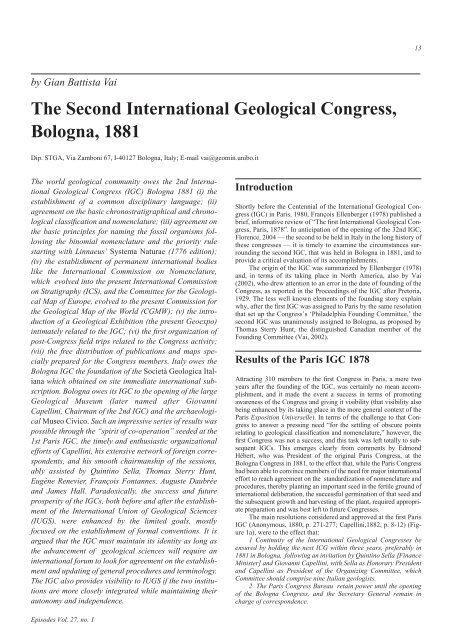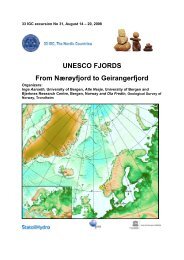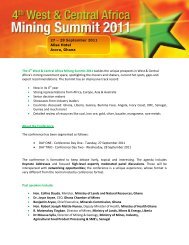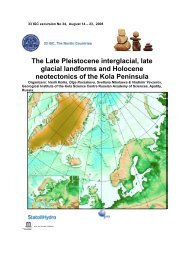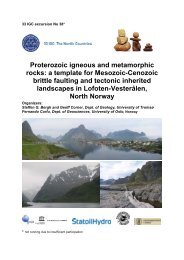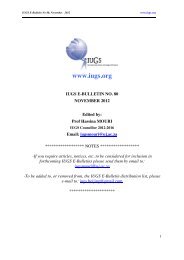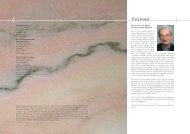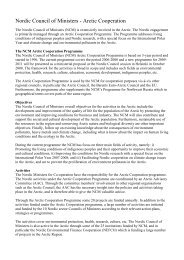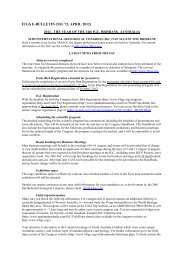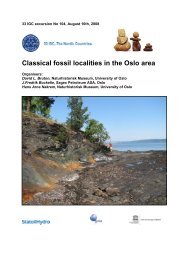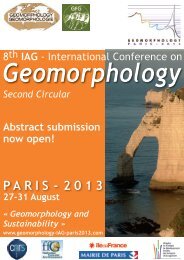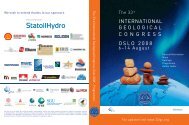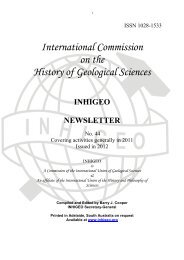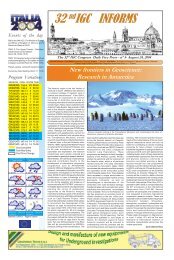The Second International Geological Congress, Bologna, 1881 - IUGS
The Second International Geological Congress, Bologna, 1881 - IUGS
The Second International Geological Congress, Bologna, 1881 - IUGS
You also want an ePaper? Increase the reach of your titles
YUMPU automatically turns print PDFs into web optimized ePapers that Google loves.
y Gian Battista Vai<br />
<strong>The</strong> <strong>Second</strong> <strong>International</strong> <strong>Geological</strong> <strong>Congress</strong>,<br />
<strong>Bologna</strong>, <strong>1881</strong><br />
Dip. STGA, Via Zamboni 67, I-40127 <strong>Bologna</strong>, Italy; E-mail vai@geomin.unibo.it<br />
<strong>The</strong> world geological community owes the 2nd <strong>International</strong><br />
<strong>Geological</strong> <strong>Congress</strong> (IGC) <strong>Bologna</strong> <strong>1881</strong> (i) the<br />
establishment of a common disciplinary language; (ii)<br />
agreement on the basic chronostratigraphical and chronological<br />
classification and nomenclature; (iii) agreement on<br />
the basic principles for naming the fossil organisms following<br />
the binomial nomenclature and the priority rule<br />
starting with Linnaeus’ Systema Naturae (1776 edition);<br />
(iv) the establishment of permanent international bodies<br />
like the <strong>International</strong> Commission on Nomenclature,<br />
which evolved into the present <strong>International</strong> Commission<br />
on Stratigraphy (ICS), and the Committee for the <strong>Geological</strong><br />
Map of Europe, evolved to the present Commission for<br />
the <strong>Geological</strong> Map of the World (CGMW); (v) the introduction<br />
of a <strong>Geological</strong> Exhibition (the present Geoexpo)<br />
intimately related to the IGC; (vi) the first organization of<br />
post-<strong>Congress</strong> field trips related to the <strong>Congress</strong> activity;<br />
(vii) the free distribution of publications and maps specially<br />
prepared for the <strong>Congress</strong> members. Italy owes the<br />
<strong>Bologna</strong> IGC the foundation of the Società Geologica Italiana<br />
which obtained on site immediate international subscription.<br />
<strong>Bologna</strong> owes its IGC to the opening of the large<br />
<strong>Geological</strong> Museum (later named after Giovanni<br />
Capellini, Chairman of the 2nd IGC) and the archaeological<br />
Museo Civico. Such an impressive series of results was<br />
possible through the “spirit of co-operation” seeded at the<br />
1st Paris IGC, the timely and enthusiastic organizational<br />
efforts of Capellini, his extensive network of foreign correspondents,<br />
and his smooth chairmanship of the sessions,<br />
ably assisted by Quintino Sella, Thomas Sterry Hunt,<br />
Eugène Renevier, François Fontannes, Auguste Daubrée<br />
and James Hall. Paradoxically, the success and future<br />
prosperity of the IGCs, both before and after the establishment<br />
of the <strong>International</strong> Union of <strong>Geological</strong> Sciences<br />
(<strong>IUGS</strong>), were enhanced by the limited goals, mostly<br />
focused on the establishment of formal conventions. It is<br />
argued that the IGC must maintain its identity as long as<br />
the advancement of geological sciences will require an<br />
international forum to look for agreement on the establishment<br />
and updating of general procedures and terminology.<br />
<strong>The</strong> IGC also provides visibility to <strong>IUGS</strong> if the two institutions<br />
are more closely integrated while maintaining their<br />
autonomy and independence.<br />
Episodes Vol. 27, no. 1<br />
Introduction<br />
Shortly before the Centennial of the <strong>International</strong> <strong>Geological</strong> <strong>Congress</strong><br />
(IGC) in Paris, 1980, François Ellenberger (1978) published a<br />
brief, informative review of “<strong>The</strong> first <strong>International</strong> <strong>Geological</strong> <strong>Congress</strong>,<br />
Paris, 1878”. In anticipation of the opening of the 32nd IGC,<br />
Florence, 2004 — the second to be held in Italy in the long history of<br />
these congresses — it is timely to examine the circumstances surrounding<br />
the second IGC, that was held in <strong>Bologna</strong> in <strong>1881</strong>, and to<br />
provide a critical evaluation of its accomplishments.<br />
<strong>The</strong> origin of the IGC was summarized by Ellenberger (1978)<br />
and, in terms of its taking place in North America, also by Vai<br />
(2002), who drew attention to an error in the date of founding of the<br />
<strong>Congress</strong>, as reported in the Proceedings of the IGC after Pretoria,<br />
1929. <strong>The</strong> less well known elements of the founding story explain<br />
why, after the first IGC was assigned to Paris by the same resolution<br />
that set up the <strong>Congress</strong>’s ‘Philadelphia Founding Committee,’ the<br />
second IGC was unanimously assigned to <strong>Bologna</strong>, as proposed by<br />
Thomas Sterry Hunt, the distinguished Canadian member of the<br />
Founding Committee (Vai, 2002).<br />
Results of the Paris IGC 1878<br />
Attracting 310 members to the first <strong>Congress</strong> in Paris, a mere two<br />
years after the founding of the IGC, was certainly no mean accomplishment,<br />
and it made the event a success in terms of promoting<br />
awareness of the <strong>Congress</strong> and giving it visibility (that visibility also<br />
being enhanced by its taking place in the more general context of the<br />
Paris Exposition Universelle). In terms of the challenge to that <strong>Congress</strong><br />
to answer a pressing need “for the settling of obscure points<br />
relating to geological classification and nomenclature,” however, the<br />
first <strong>Congress</strong> was not a success, and this task was left totally to subsequent<br />
IGCs. This emerges clearly from comments by Edmond<br />
Hébert, who was President of the original Paris <strong>Congress</strong>, at the<br />
<strong>Bologna</strong> <strong>Congress</strong> in <strong>1881</strong>, to the effect that, while the Paris <strong>Congress</strong><br />
had been able to convince members of the need for major international<br />
effort to reach agreement on the standardization of nomenclature and<br />
procedures, thereby planting an important seed in the fertile ground of<br />
international deliberation, the successful germination of that seed and<br />
the subsequent growth and harvesting of the plant, required appropriate<br />
preparation and was best left to future <strong>Congress</strong>es.<br />
<strong>The</strong> main resolutions considered and approved at the first Paris<br />
IGC (Anonymous, 1880, p. 271-277; Capellini,1882, p. 8-12) (Figure<br />
1a), were to the effect that:<br />
1 Continuity of the <strong>International</strong> <strong>Geological</strong> <strong>Congress</strong>es be<br />
ensured by holding the next ICG within three years, preferably in<br />
<strong>1881</strong> in <strong>Bologna</strong>, following an invitation by Quintino Sella [Finance<br />
Minister] and Giovanni Capellini, with Sella as Honorary President<br />
and Capellini as President of the Organizing Committee, which<br />
Committee should comprise nine Italian geologists.<br />
2 <strong>The</strong> Paris <strong>Congress</strong> Bureau retain power until the opening<br />
of the <strong>Bologna</strong> <strong>Congress</strong>, and the Secretary General remain in<br />
charge of correspondence.<br />
13
14<br />
Figure 1a Giovanni<br />
Capellini, President of<br />
the <strong>Second</strong> <strong>International</strong><br />
<strong>Geological</strong> <strong>Congress</strong>.<br />
3 <strong>The</strong> questions placed before the<br />
Paris <strong>Congress</strong> be reported on at the<br />
<strong>Bologna</strong> <strong>Congress</strong>, having been studied<br />
in the interim by two international Commissions,<br />
one for the unification of geological<br />
symbols (A.R.C. Selwyn, President;<br />
E. Renevier, Secretary), the other<br />
for the unification of the geological<br />
nomenclature (E. Hébert, President; G.<br />
Dewalque, Secretary). Members representing<br />
the participating countries be<br />
named to the Commissions, and that this<br />
membership be augmented by representatives<br />
of countries not present at the<br />
Paris <strong>Congress</strong>, and the country-members<br />
designated set up a local Committee<br />
to report to the international Commissions.<br />
<strong>The</strong> reports prepared by the two<br />
Commissions, together with those of the local Committees, reach the<br />
Organizing Committee by January 1st, <strong>1881</strong>, so as to be printed and<br />
distributed before the opening of the <strong>Bologna</strong> <strong>Congress</strong>.<br />
4 A [French] Commission be established to study the question<br />
of common rules for establishing the nomenclature of species in both<br />
palaeontology and mineralogy. (Translated by the present writer).<br />
Ellenberger (1978) acknowledged these same outcomes of the<br />
Paris <strong>Congress</strong>, adding critically that the <strong>Congress</strong> had failed<br />
as a mechanism for methodologically confronting the work and<br />
problems then facing the geological community of the world. No<br />
international geological exhibition was assembled, the times allotted<br />
for papers and discussions were far too limiting, national representation<br />
was very much out of proportion, the themes proposed were<br />
often hardly touched upon and were at times replaced by widely disparate<br />
presentations of variable scientific interest (p. 24).<br />
An additional remark that “several of the major contemporary<br />
areas of dispute were not covered” (Ellenberger, 1978, p. 24) seems<br />
excessively harsh, or even unjustified, criticism because the stated aim<br />
of the first IGC was “the settling of many obscure points relating to geological<br />
classification and nomenclature,” as requested by the Philadelphia<br />
Founding Committee (Mendenhall, 1877, p. 355; Vai, 2002).<br />
<strong>The</strong> speeches given in Paris by James Hall and Joachim Barrande,<br />
the two leading palaeontologists attending the <strong>Congress</strong>, are<br />
worthy of mention. Hall, Capellini’s good friend since 1863, lucidly<br />
expressed his view on the comparative correlation method in stratigraphy,<br />
which was based on a number of principles, including priority,<br />
that are still hold to be valid. Hall’s remarks, therefore, were<br />
fully in keeping with the objectives of both the Founding Committee<br />
and the <strong>Congress</strong> itself (Anonymous, 1880, p. 60-67). Barrande,<br />
praising the American stratigrapher, criticized “our teachers Murchison<br />
and Sedgwick,” who “had neglected palaeontology.” He emphasized<br />
the value of his own major faunal units, and pronounced the<br />
“discussions on nomenclature to be completely useless” (Anonymous,<br />
1880, p.101-106). This view anticipated the approach of the<br />
bio-ortho-chronological German school that still has some supporters<br />
and strongly contrasts with the pragmatic stratigraphic approach<br />
introduced at the <strong>Bologna</strong> IGC and followed subsequently by the<br />
majority of stratigraphers. In any case, it is not true to say that<br />
Murchison and Sedgwick (and especially Murchison) “neglected<br />
Figure 1b Felice<br />
Giordano, Secretary<br />
General, and<br />
Giuseppe Scarabelli,<br />
Treasurer, 2nd IGC<br />
<strong>Bologna</strong> <strong>1881</strong>.<br />
palaeontology”, though this was appropriate of Sedgwick’s early<br />
work in rocks that contained few easily found fossils.<br />
Organization of the <strong>Second</strong><br />
<strong>International</strong> <strong>Geological</strong> <strong>Congress</strong>,<br />
<strong>Bologna</strong>, <strong>1881</strong><br />
Thomas Sterry Hunt, who played a major role in both the Philadelphia<br />
Founding Committee and the 1st IGC, Paris, 1878, suggested<br />
that the 2nd IGC be held in <strong>Bologna</strong> under the presidency of<br />
Capellini. His suggestion was unanimously accepted by the Bureau<br />
and the Council and acclaimed by the General Assembly on September<br />
4, 1878 (Anonymous, 1880, 1882). Hunt knew very well that<br />
Capellini, being in agreement with the aims of the Founding Committee,<br />
was the man best able to mediate and succeed in the difficult<br />
task of establishing a common terminology for geology and geological<br />
mapping (Vai, 2002). Capellini, in turn, having contributed significantly<br />
to the adoption of the Paris resolutions, started work<br />
immediately. He completed the composition of the Organizing Committee<br />
(OC) (Figure 1b) by adding new members to the ten<br />
appointed at the Paris <strong>Congress</strong> and obtaining the ‘High Patronage’<br />
of King Umberto I of Italy, who, as a prince, had already attended in<br />
person the 5th <strong>International</strong> <strong>Congress</strong> of Anthropology and pre-Historical<br />
Archaeology, organized in <strong>Bologna</strong> by Capellini in 1871.<br />
Following Capellini’s proposals, the OC decided that a <strong>Geological</strong>-Palaeontological<br />
Exhibition should be held during the <strong>Congress</strong><br />
in the <strong>Geological</strong> Institute of <strong>Bologna</strong> University; that a volume containing<br />
a <strong>Geological</strong> and Palaeontological Bibliography of Italy be<br />
printed (Figure 2) and distributed to the attending members; and a<br />
logo for the IGC be adopted, with the Latin inscriptions Geologorum<br />
Conventus and Mente et Malleo inserted in a circle with two crossing<br />
hammers in the centre (Figure 3). <strong>The</strong> logo was accompanied by an<br />
emblem, distributed also as a badge and medal, showing the number,<br />
date, and venue of the <strong>Congress</strong>, with the<br />
coat of arms of the Kingdom of Italy and of<br />
the city of <strong>Bologna</strong> (Figure 4). Both were<br />
published as a frontispiece to the <strong>Bologna</strong><br />
Proceedings volume (Anonymous, 1882).<br />
An exciting account of how the logo was<br />
conceived is to be found in Capellini (1914,<br />
v. 2, p. 266-268). An estimated cost for the<br />
<strong>Congress</strong> was set at “50,000 lire” (about<br />
158,000 euros, the Italian lira being equivalent<br />
to the French franc at the time). Financial<br />
contributions came from the Italian<br />
Government, the King, and the City of<br />
<strong>Bologna</strong> and its Province, with Marco<br />
Minghetti and Quintino Sella (both future<br />
Prime Ministers of Italy) helping considerably<br />
(Capellini, 1914, v. 2, p. 266).<br />
<strong>The</strong> First Circular of the <strong>Congress</strong> was<br />
issued on April 30, 1879, more than two<br />
years before the convention was to open.<br />
<strong>The</strong> registration fee was set at 12 French<br />
francs, being equal to 3.86 g of gold<br />
according to Ellenberger (1978) or 12 lire<br />
for Italian registrants being equal to about<br />
38 euros. This was the level that had prevailed<br />
for the Paris <strong>Congress</strong> three years<br />
prior, and it proved adequate to supply each<br />
member with a copy of the Proceedings<br />
volume gratis and with other publications<br />
of the <strong>Congress</strong>.<br />
One year later the King of Italy<br />
granted the OC the sum of 6,000 French<br />
francs (about 19,000 euros) to encourage<br />
Figure 2 Frontispiece<br />
of the Bibliographie<br />
complimentary<br />
offered to the<br />
<strong>Congress</strong> members<br />
(Capellini Museum).<br />
Figure 3 General<br />
logo for the IGCs<br />
designed by Capellini<br />
(Anonymous, 1882).<br />
March 2004
Figure 4 Emblem<br />
used for badge and<br />
medal of the 2nd IGC<br />
(Anonymous, 1882).<br />
geological studies. Capellini and the OC<br />
immediately decided to establish a fund<br />
to underwrite the costs of internationally<br />
evaluating geological symbols to be used<br />
on maps, as a practical means of arriving<br />
at an acceptable global standard (Anonymous,<br />
1882, p. 18–19; Capellini, 1914, v.<br />
2, p 255).<br />
<strong>The</strong> <strong>Second</strong> Circular was issued on<br />
June 1, 1880. Although in keeping with<br />
the letter of the Paris resolutions, this circular<br />
was clearly innovative in its proposed<br />
procedure for organizing the IGC.<br />
<strong>The</strong> circular reaffirmed the resolutions<br />
adopted in Paris in 1878, “to obtain more certainly a practical result<br />
from the <strong>Bologna</strong> session” (Anonymous, 1882, p. 20). Hence, the<br />
focus of the <strong>Bologna</strong> <strong>Congress</strong> was on achieving two primary goals:<br />
(a) standardizing geological symbols; and (b) standardizing geological<br />
nomenclature. It was considered important to have a “well<br />
defined program” for the second IGC.<br />
Factors such as distance between the home bases of the members<br />
of the two Commissions, together with experience gained during<br />
a meeting of some members of the Commissions with the ICG<br />
Council in Paris, from 1 to 3 April, 1880, revealed, nonetheless, the<br />
difficulty of reaching agreement, especially on the issue of standardized<br />
geological symbols for maps (with emphasis initially on smallscale<br />
maps). It was for this reason, therefore, that Capellini and his<br />
OC proposed the further international evaluation of the symbols<br />
issue based on practical solutions to be advanced by individual private<br />
geologists. <strong>The</strong> deadline for submitting written proposals to<br />
President Capellini, for consideration by the international evaluative<br />
panel was set as the end of May, <strong>1881</strong>.<br />
<strong>The</strong> OC updated the by-laws of the Paris IGC introducing,<br />
among others things, the distinction between effective and adhering<br />
<strong>Congress</strong> members and the conditions required for registration of both<br />
domestic (more restricted) and foreign (more open) registrants. This<br />
was ratified by the IGC Council at a meeting in Paris on April 2, 1880.<br />
Reports prepared by the two international Commissions for the<br />
standardization of nomenclature and symbols and that by the Commission<br />
for species nomenclature in palaeontology were printed in a<br />
144-page volume (Figure 5) that was sent to registered <strong>Congress</strong><br />
members, the geological societies, and the majority of individual<br />
geologists worldwide, together with the short Third Circular for the<br />
<strong>Bologna</strong> <strong>Congress</strong>, dated June 15, <strong>1881</strong>. <strong>The</strong> deadline for submitting<br />
proposed presentations was set as the end of August, <strong>1881</strong>.<br />
<strong>The</strong> General Program prepared for the <strong>Bologna</strong> <strong>Congress</strong> was<br />
scientifically well delimited, and it had a good balance among formal<br />
sessions, business, and other more informal meetings, and social<br />
activities, the entire program of events running from September 25<br />
to October 5, <strong>1881</strong>. Sunday, September 25,<br />
was devoted to the Council Meeting, an<br />
inaugural (re)-opening of the archaeological<br />
Museo Civico of <strong>Bologna</strong>, and the ‘icebreaker’<br />
party in the ancient building of the<br />
<strong>Bologna</strong> University, the Palazzo<br />
dell’Archiginnasio (Figure 6). <strong>The</strong> next<br />
day, Monday the 26 th , was left to the official<br />
opening of the <strong>Congress</strong> and the <strong>Geological</strong><br />
Exhibition, with essentially the fullday<br />
made available to visit the latter. Two<br />
middle-of-the-day sessions (from noon to<br />
about 4 p.m.) were scheduled on September<br />
27 and 28 for the standardization of geological<br />
nomenclature, and two ensuing, separate<br />
sessions, on September 29 to 30, for the<br />
standardization of geological symbols. Saturday<br />
October 1, was given over to a session<br />
on the rules for species nomenclature.<br />
<strong>The</strong> following Sunday, October 2, allowed<br />
Episodes Vol. 27, no. 1<br />
Figure 5 Frontispiece<br />
of the Rapports by the<br />
Commissions<br />
circulated to the<br />
registrants three<br />
month before the<br />
<strong>Congress</strong> (Capellini<br />
Museum).<br />
for a trip to the city of<br />
Imola to visit the Natural<br />
History Museum assembled<br />
by Giuseppe Scarabelli<br />
(<strong>Congress</strong> Treasurer)<br />
and to examine his map of<br />
the Quaternary geology of<br />
the nearby Monte Castellaccio<br />
where a Bronze-age<br />
settlement was under excavation.<br />
October 3 and 4<br />
were devoted to two additional<br />
scientific sessions,<br />
and the official closing<br />
session of the <strong>Congress</strong><br />
was held on October 5, <strong>1881</strong>. Post-<strong>Congress</strong> field trips and excursions<br />
included ones to the cities of Porretta (in the core of the Bolognese<br />
Apennines), Florence, Pisa, and Carrara (in the Apuane Alps).<br />
For the entire duration of the <strong>Congress</strong>, the Museo Civico, the<br />
City libraries, and the Natural History Museums of the University<br />
were open to participants without charge. Free transportation was<br />
offered for the trip to the Carrara marble quarries, and a reduced-cost<br />
ticket was provided for the journey back to home.<br />
<strong>The</strong> <strong>Second</strong> IGC Meets<br />
Everything was ready on September 25th to welcome the distinguished<br />
guests from 22 countries outside Italy. Registered members<br />
totalled 421, attending members 216. <strong>The</strong> sessions were held in the<br />
ad hoc restored building of the musical Liceo Rossini (Figure 7), the<br />
first <strong>Geological</strong> Exhibition in the halls of the <strong>Geological</strong> Institute and<br />
Museum. <strong>The</strong> two places were both within walking distance of the<br />
main University buildings. <strong>The</strong> large Concert Hall (now Sala Bossi),<br />
site of the <strong>Congress</strong> plenary sessions, was dominated by the flags of<br />
the USA, France, and Italy to signify the roots and history of the IGC.<br />
Additional rooms were available for the Council, the <strong>Congress</strong> Secretaries,<br />
the press, and special gatherings. Each registered member<br />
found at the welcoming desk his ticket with name, the elegant badge<br />
of the <strong>Congress</strong>, a City map, and the following publications: (1) <strong>Geological</strong><br />
and palaeontological bibliography of Italy (630 p.), (2) History<br />
of the Academy of Sciences of the <strong>Bologna</strong> Institute (280 p.), (3)<br />
Statistics of the domestic mineral industry (1860-1880), (4) <strong>Geological</strong><br />
Map of Italy (1:1,111,111) in two sheets, (5) <strong>Geological</strong> Maps of<br />
the surroundings of <strong>Bologna</strong> and the Leghorn Mountains (1:<br />
100.000), and the Surrounding of la Spezia (1:50,000), (6) Catalogue<br />
of the <strong>Bologna</strong> <strong>Geological</strong> Museum, (7) Catalogue of the <strong>Geological</strong><br />
Exhibition (Anonymous, 1882).<br />
On Sunday, the 25th, the members were invited to the inaugural<br />
opening of the renewed Museo Civico with its famous archaeological<br />
collections, especially that of the<br />
Umbrian and Etruscan necropolis<br />
recently excavated in the surroundings of<br />
<strong>Bologna</strong>. For the entire duration of the<br />
<strong>Congress</strong>, the city offered members free<br />
evening meeting rooms in the ancient<br />
halls of the Archiginnasio palace. On<br />
September 29, the municipality offered a<br />
concert by its famous Teatro Comunale<br />
Orchestra. A delightful farewell party<br />
(with buffet, music, and fireworks) was<br />
thrown by Capellini and his wife, Lady<br />
Beatrice Niccolini, in the large Italiantype<br />
garden at the back of the <strong>Geological</strong><br />
Institute and Capellini’s house. This event<br />
was held under favourable weather conditions<br />
in an otherwise raining <strong>Congress</strong>.<br />
<strong>The</strong> solemn opening session on<br />
Monday, the 26th was chaired by the<br />
15<br />
Figure 6 Inner court of Palazzo<br />
dell’Archiginnasio, site of the icebreaker<br />
party opening the 2nd IGC<br />
<strong>Bologna</strong> <strong>1881</strong>.<br />
Figure 7 Ancient portal<br />
of the musical Liceo<br />
Rossini, session site of<br />
the 2nd IGC <strong>Bologna</strong><br />
<strong>1881</strong>.
16<br />
Minister of Agriculture, Industry, and Trade, Domenico Berti,<br />
assisted by the Honorary President, Sella, the Past- President, Hébert,<br />
the President of the Organizing Committee, Capellini, and the members<br />
of the Bureau of the Paris IGC who were present in <strong>Bologna</strong>, viz.,<br />
Daubrée, Hall, Sterry Hunt, Val. Moeller, Gregory Stefanesco, Joszef<br />
Szabo, Otto Torell, Juan Vilanova, and Alexis Delaire. <strong>The</strong> Presiding<br />
Council of the <strong>Congress</strong> was composed according to the statute (50<br />
members, including 15 from Italy) and the Board of the <strong>Congress</strong><br />
was elected (32 members, including 9 from Italy).<br />
Sella (Figure 8) suggested the official<br />
(yet not exclusive) use of the French as the language<br />
understood by most guest members.<br />
Proud to be able to speak also as President of<br />
the Italian Academy of Sciences (Lincei), he<br />
advocated a positive, interdisciplinary<br />
approach by geologists to their science and to<br />
all other sciences, and in turn asked the biological<br />
and material sciences to trust geology to<br />
solve some of the major issues facing<br />
Figure 8 Quintino<br />
Sella, Honorary<br />
President of the<br />
2nd IGC <strong>Bologna</strong><br />
<strong>1881</strong> (courtesy<br />
Fondazione Sella,<br />
Biella).<br />
mankind. Expressing his gratitude to both the<br />
IGC for having voted for an Italian venue and<br />
his friend Capellini for the excellent organization<br />
of the <strong>Congress</strong>, he paid tribute to the role<br />
played by <strong>Bologna</strong> in teaching and contributing<br />
to the advancement of science. In so doing,<br />
he quoted Sterry Hunt’s speech at the closing<br />
session of the Paris IGC in which he referred<br />
to the practical benefits accruing from pioneering geological studies<br />
conducted by the ancient Italian scientists of the <strong>Bologna</strong> University.<br />
<strong>The</strong> support of the City and its Province was promptly forthcoming,<br />
Sella pointed out, because, for both of these, there was already wide<br />
recognition of the practical applications that could result from<br />
informed observations on local rocks. <strong>The</strong> cult of science in <strong>Bologna</strong><br />
was so deep that local trade unions, with many workers, came to<br />
honour the significant contributions geologists had made to the<br />
material and intellectual progress of mankind. <strong>The</strong> Italian Government<br />
had obtained from Parliament a substantial financial contribution<br />
to ensure the quality and success of the <strong>Congress</strong>, Sella<br />
explained, and the Government had also provided 92,000 French<br />
francs (about 285,000 euros) for the large-scale <strong>Geological</strong> Map of<br />
Italy (see also Corsi, 2003), a first annual contribution that, while<br />
perhaps not to be compared to the ca. 900,000 francs (about 2.7 million<br />
euros) made available to the <strong>Geological</strong> Survey in England, it<br />
was, nonetheless, a notable contribution when set in context of the<br />
current financial problems facing Italy. On the key, declared objectives<br />
of the <strong>Bologna</strong> <strong>Congress</strong>, Sella had this to say:<br />
<strong>The</strong> history of the Earth is controlled by both discontinuous and<br />
continuous sedimentary and biologic processes. If nature is operating<br />
continuously, establishing artificial subdivisions is very hard.<br />
Your talent and your presence here makes me feel that the <strong>Bologna</strong><br />
<strong>Congress</strong> will reach some agreements on geological nomenclature<br />
and symbols or set the basis for reaching it in the near future.<br />
Sella’s appeal for interdisciplinarity anticipated an approach that<br />
did not surface widely until after the Plate Tectonic Revolution in the<br />
1967–1970. His wide acceptance of the obvious links between academic<br />
geology and practical (economic) geological applications was<br />
sensible and could have been used as a model, instead of allowing the<br />
rift between academic and economic geology of the twentieth century<br />
to develop as it did in so many universities in Europe and North<br />
America, to the detriment of both “states of the geological realm.” By<br />
the same token, Sella’s clear recognition of continuity and inter-systemic<br />
involvement in natural processes and natural materials with the<br />
resultant artificiality of man-made classification (a mere convenience<br />
for reasons of communication) is well worth noting.<br />
Hébert emphasized the superb organization and the size and<br />
importance of both the new Capellini Museum and the <strong>Geological</strong><br />
Exhibition in terms of the aims of the <strong>Congress</strong>. <strong>The</strong> scientific<br />
engagement of the new Italian Kingdom had found in <strong>Bologna</strong> the<br />
leading centre where the cult for science had never been abandoned.<br />
Capellini’s speech captured the audience by its international<br />
flavour. Geology, “after a first fabulous age and a second heroic<br />
age”, had, only in the last century started its new modern age with<br />
the foundation of the <strong>Geological</strong> Society of London in 1807 and<br />
William Smith’s pioneer mapping on topographical sheets of the<br />
bedrock surface of England. Thus, geology was no longer ancillary<br />
to mineralogy, nor was it any longer the simple geognosy of the<br />
rocks of the past. <strong>The</strong> founding of the scientific congresses in<br />
Switzerland (1815) and Germany (1823) were important steps in<br />
propelling science and geology into a more liberal, open, and international<br />
environment. <strong>The</strong> founding of the Société Géologique de<br />
France (1830), the British Association for the Advancement of Sciences<br />
(1831), and the <strong>Congress</strong>o degli Scienziati Italiani (1839)<br />
were means of encouraging geologists all over Europe to meet with<br />
one another and associate with other scientists. <strong>The</strong> same was now<br />
happening even faster in the USA, where geological studies had<br />
been absent at the beginning of the century. Stimulating as these<br />
changes were, there could be no diminution in their prosecution,<br />
Capellini implied, because it would take decades before such<br />
national scientific meetings, however open, became truly international<br />
congresses. Capellini had already enjoyed the opportunity to<br />
found the <strong>International</strong> <strong>Congress</strong> of Anthropology and pre-Historical<br />
Archaeology in 1865 at La Spezia. Many other sciences were<br />
soon to follow the same path. After giving a brief outline of the origin<br />
of IGC, the Paris <strong>Congress</strong>, and the preparations for the <strong>Bologna</strong><br />
<strong>Congress</strong>, Capellini concluded by listing the credentials of the<br />
<strong>Bologna</strong> school in geology, mentioning the names of Aldrovandi,<br />
Cospi, Marsigli, Monti, Beccari, and others from the 16th to the 18th<br />
century. Summarizing the important draft resolutions agreed among<br />
the members of the Commissions as a basis for discussion during the<br />
<strong>Congress</strong>, his final call was: go forward!<br />
Out of the six memoirs presented in the international juried<br />
competition for standardization of geological symbols, three were<br />
considered worthy of prize (Albert Heim, 2,000 francs; Alexander<br />
Karpinsky, 1,200 francs; M. Maillard, 800 francs). None, however,<br />
was found entirely to satisfy the conditions required by the competition.<br />
After reading the memoirs (Anonymous, 1882, p. 281–411),<br />
one has to agree that this decision was correct. Heim’s contribution<br />
was scientifically well based and technically exhaustive. However,<br />
Heim was not aware that the stratigraphic subdivisions that could be<br />
agreed upon most easily were those established artificially or by convention<br />
and not those based on “natural” boundaries in the rocks<br />
themselves (Anonymous, 1882, p. 290). <strong>The</strong> two other contributions<br />
were less outstanding.<br />
Scientific Program and Working Reports<br />
<strong>The</strong> basic questions placed before the <strong>Bologna</strong> IGC called for finding<br />
solutions to the problems of standardizing,<br />
(1) the geological nomenclature concerning stratigraphical<br />
division of the Earth’s rocks;<br />
(2) the geological symbols of maps and profiles; and<br />
(3) the rules for naming species in both palaeontology and<br />
mineralogy.<br />
<strong>The</strong> official reports of the two ad hoc international Commissions<br />
and the French Commission set up in 1878 at the Paris IGC had<br />
been printed in a 144-page booklet that was widely circulated in<br />
June, <strong>1881</strong>. <strong>The</strong> reports had been compiled and discussed after the<br />
receipt of reports prepared by the National Committees of Austria,<br />
Belgium, Spain and Portugal, France, Great Britain and Ireland,<br />
Hungary, Italy, Russia, and Switzerland (the reports from Australia,<br />
Canada, and the USA were submitted only at the opening of the <strong>Congress</strong>,<br />
after the deadline). Over 150 specialists were consulted by the<br />
National Committees, and all had reported on time. Remarkably, no<br />
fewer than 64 contributions arrived to the British-Irish Committee.<br />
Among those specialists were the most prominent stratigraphers and<br />
structural geologists of the time, as for example, <strong>The</strong>odor Fuchs,<br />
Franz Hauer, Eduard Suess, Franz Toula; Laurent De Koninck;<br />
March 2004
Albert Auguste De Lapparent, Charle Barrois; Archibald Geikie,<br />
Charles Lapworth, Joseph Prestwich, Whitaker; Gaetano Gemmellaro,<br />
Giuseppe Meneghini; Val. Moeller, Alexander Karpinsky;<br />
Charles Mayer-Eymar). Additionally, the individual memoirs submitted<br />
to the international juried competition (see above) were made<br />
available for discussion.<br />
<strong>Congress</strong> activity<br />
Two-day sessions were devoted to each of items 1 and 2 (above); a<br />
one-day session was left to item 3. Preliminary discussion of item 1<br />
started on the use of words like rock and formation. Should the term<br />
rock be restricted to the lithic masses (e.g. eruptive rocks), as<br />
claimed by a minority of French specialists, or should it be applicable<br />
also to loose sedimentary deposits, as suggested by the Commission<br />
(and enthusiastically supported from the floor by the Italian delegation)?<br />
<strong>The</strong> view of the Commission prevailed. As for the word<br />
formation, a certain disagreement between the French and British, as<br />
to whether the term should carry also a chronological implication,<br />
was solved by accepting the proposal of the Commission to restrict<br />
the term to lithology and mode of origin only.<br />
Debate proceeded at a high conceptual and scientific level point<br />
by point through paragraph by paragraph, steady progress being<br />
punctuated only by some hardening of positions on choices arising<br />
from the use of different terms in different countries for the same<br />
high-rank stratigraphic unit, as for example, group and terrain.<br />
Hard-fought debate prompted the Commission to suggest the informal<br />
use of one of the competing terms in the plural, for example,<br />
“secondary terrains”. <strong>The</strong> <strong>Congress</strong>, however, voted for the specific<br />
use of the term group (later replaced by erathem). It was suggested<br />
that the terms favoured should be readily translated into different<br />
languages, and hence, as suggested by the Commission, the term<br />
system was adopted to replace terrain, for such divisions as the<br />
Devonian System.<br />
Hébert, Past-President of the IGC, and Renevier, Secretary of<br />
the Commission to address the problem of common symbols for geological<br />
maps and profiles, suggested alternative use of the terms<br />
rejected by the voted decisions, with a view to favouring mutual concession<br />
in instances of contrast on first-order terms. Despite<br />
Renevier’s efforts, however, these contrasts remained sharp and<br />
positions taken from the floor hardened, especially between the<br />
French and German delegates and between old and young. Additional<br />
problems arose from paragraphs already approved, which<br />
changed some of the names suggested by the Commission for stratigraphical<br />
divisions of the geological column and carried implications<br />
for further changes of names in the paragraphs still being, or to<br />
be, discussed. <strong>The</strong> leading role played by Renevier to assure adoption<br />
of all paragraphs prepared by the Commission, after incorporating<br />
such changes as were agreed to by a majority of the <strong>Congress</strong>, is<br />
evident from the minutes of the sessions (Delaire and Fontannes,<br />
1882, p. 57-195). Renevier (Figure 9) showed great skill by supporting<br />
views coming from the floor that were designed to promote convenience,<br />
and by opposing motions calling for<br />
delays of decisions or for the excision of paragraphs<br />
that had raised conflicting views. By<br />
such procedures was the term series also<br />
adopted after a written review that revealed<br />
clear signs of irritation on the part of prominent<br />
members of the German and Russian delegations.<br />
This first written scrutiny revealed<br />
the relatively high number of Italian voting<br />
members. <strong>The</strong> point was duly noted by Sella<br />
— a fair-minded politician with a finely honed<br />
sense of propriety — in the course of seeking<br />
compromise not only for use of the term series<br />
but also, more generally, on reliable procedures<br />
for the future smooth working of the<br />
<strong>Congress</strong>. As a consequence, therefore, the<br />
Episodes Vol. 27, no. 1<br />
Figure 9 Eugène<br />
Renevier played a<br />
leading role in the<br />
2nd IGC <strong>Bologna</strong><br />
<strong>1881</strong>.<br />
paragraph just passed following written scrutiny was left to further<br />
consideration by the Council. Discussion and voting turned to the<br />
ensuing paragraphs, with the term stage being rapidly adopted. At<br />
the opening of the second session, the Assembly adopted the conclusion<br />
of the Council, to the effect that the term series should be<br />
retained as adopted, but with the rider that its synonyms in the main<br />
languages be listed with it.<br />
<strong>The</strong> compromise reached and accepted for the single case of<br />
series gave rise to further dissenting views, unexpectedly supported,<br />
and even interpreted, by an active Past-President. Motions were presented<br />
to reopen discussion on decisions already made. A few Italian<br />
members, trying to mediate, moved for a change in the procedures<br />
that were followed in the first-day discussion. Capellini, breaking for<br />
the first time his vow of self-imposed discretion, claimed that such<br />
procedural motions should have been placed with the Council earlier,<br />
and called for continuing discussion and adoption of the international<br />
report. Sella seconded Capellini’s view in an effort to obviate<br />
the possibility of failure of the <strong>Congress</strong>.<br />
<strong>The</strong> remarks made and courses of action adopted seemed to<br />
have had a positive impact for further paragraphs were adopted without<br />
significant alteration. Dissent, however, was revived again when<br />
discussion moved to the chronological divisions of the geological<br />
column to correspond to the [chrono]stratigraphic divisions already<br />
adopted.<br />
Two parties began to emerge from the discussions: (1) an international<br />
party, which was concerned about freedom of choice and<br />
the advancement of geology, seeking to assure the adoption of common<br />
procedures and a common language emanating from the Commission<br />
reports; and (2) a national party, which was open to some<br />
agreement, but was concerned mainly with maintaining the independence,<br />
and defending the interests, of the major countries, including<br />
the prominence accruing to them from international acceptance of<br />
their practices and terminology. <strong>The</strong> first party included Capellini,<br />
Renevier, Fontannes, Daubrée, Sterry Hunt, Blanford, Vilanova, and<br />
Sella, and was supported by most Italian members. <strong>The</strong> second party<br />
included Hébert, Beyrich, Moeller, Stefanesco, Zittel, and most of<br />
the German, Austrian, and Russian members. Although very active<br />
in discussion, the national party rarely succeeded because of the frequent<br />
disagreements between French and German members. So,<br />
despite being “a house divided,” 22 paragraphs of Report 1 were<br />
adopted by the assembly in original or modified form.<br />
<strong>The</strong> <strong>1881</strong> IGC, alas, had to face still more difficult questions. To<br />
avoid further risk of impairing the declared objectives of the <strong>Bologna</strong><br />
<strong>Congress</strong>, at the opening of the third-day session, Daubrée, the distinguished<br />
French Vice-President of the <strong>Congress</strong> and a close friend<br />
of Capellini, suggested that Capellini take the chair for the remaining<br />
three sessions to ensure accomplishment of the <strong>Congress</strong>’s agenda.<br />
For the two previous sessions, Capellini had chosen to relinquish the<br />
chair to different vice-presidents. Capellini accepted Daubrée’s proposal<br />
with alacrity and opened discussion on item (2).<br />
<strong>The</strong> Commission for the <strong>Geological</strong> Map of Europe, set up during<br />
preparations for the <strong>Bologna</strong> IGC and chaired by Capellini<br />
(Anonymous, 1882, p. 131), had recommended: (i) that Berlin be<br />
selected as the place where the map should be prepared, and (ii) that<br />
a controlling committee be put in place, with members from Germany,<br />
Austria-Hungary, France, Great Britain, and Russia. Replacement<br />
of the German by an Italian member, and the ex-officio addition<br />
of the Secretary of Commission 2 was suggested. <strong>The</strong> Commission 2<br />
report, however, had suggested establishment of an <strong>International</strong><br />
<strong>Geological</strong> Bureau to oversee not only the content of the map but<br />
also its preparation (Renevier, <strong>1881</strong>, p.104–109). Hence, conflicting<br />
national vs international schools of thought arose again, with<br />
Renevier as the astute and proud defender of the international forces,<br />
which were pitted against the German and other nationalist forces.<br />
Capellini played the role of mediator, striving in a thoroughly pragmatic<br />
way to maintain the maximum possible degree of international<br />
co-operation, sufficient certainly to retain the commitment of all<br />
major countries to accomplishing the project’s objectives. What happened<br />
then in a sense foreshadowed the kinds of decisions reached<br />
today in a quest for unity within the European Community. It was<br />
17
18<br />
agreed to entrust to Germany the preparation of the <strong>Geological</strong> Map<br />
of Europe at a scale 1:1,500,000 and to set up an <strong>International</strong> Committee<br />
of five plus two members to exercise permanent scientific<br />
control over the undertaking. As soon as the Committee was<br />
appointed, it was charged with the responsibility for addressing<br />
issues of nomenclature and cartographic symbolism not yet decided<br />
upon, or unlikely to be resolved easily, by the <strong>Congress</strong>. This Committee<br />
was the original seed from which sprang the subsequent Commission<br />
for the <strong>Geological</strong> Map of the World.<br />
Later discussion concentrated on the map’s symbols and especially<br />
the standard colours to be used for the principal geological<br />
divisions. Lively exchanges took place<br />
on both the physical attributes and aesthetics<br />
of the colours. Comparable discussions<br />
surrounded also the other recommendations<br />
of Commission 2. It<br />
became increasingly relevant the role of<br />
Renevier (Figure 10) to lead these discussions<br />
in the direction of adopting the suggestions<br />
of the Commission or of reaching<br />
a reasonable compromise, and in this<br />
challenge he was supported by the judicious<br />
chairmanship of Capellini. As a<br />
consequence and in final analysis, only<br />
Figure 10 Renevier’s one recommendation made by Commis-<br />
card to Capellini apolosion 2 was left to the <strong>International</strong> Comgizing<br />
for some eyes mittee, with addition of the colours to be<br />
illness and adding used for the post-Tertiary terrains. On the<br />
contributions to the latter point, however, it was already clear<br />
Bibliographie volume that most speakers favoured separating<br />
(Figure 2) (Capellini the Quaternary from both the Cenozoic<br />
Museum).<br />
and the Tertiary (Anonymous, 1882, p.<br />
156).<br />
<strong>The</strong> last session of the <strong>Congress</strong> was devoted to the report of<br />
Commission 3. <strong>The</strong> basic principles for naming organisms were<br />
agreed upon: (i) binomial nomenclature; (ii) Latin names for genera<br />
and species; and (iii) priority rule. Be that as it may, great differences<br />
in practice, however, were recognized between botanists and zoologists.<br />
<strong>The</strong>re was debate as to whether the Linnaeus’ Systema Naturae<br />
(1776 edition) should be taken as the starting point for priority in<br />
palaeontological nomenclature, or if it would have been appropriate<br />
to go back to Aldrovandi or, even earlier, to Pliny, as the Commission<br />
had suggested. Various national botanical societies warned the<br />
<strong>Bologna</strong> IGC to conform to their 1867 resolutions. <strong>The</strong>re was discussion<br />
about the need to follow binomial nomenclature and yet at<br />
the same time distinguish variability within species attributable to<br />
both geographical spread (“varieties”) and chronological change<br />
(“mutations”). Another matter for debate was the theoretical and<br />
practical importance of maintaining the name of the author of a<br />
species independent from that of the genus to which was assigned.<br />
President Capellini skilfully won adoption of all the clauses presented<br />
for discussion in the report of Commission 3, winning over<br />
conflicting groups by incorporating relevant minority views and, in<br />
opposition to the Commission’s recommendation, by limiting priority<br />
to Linnaeus’ Systema Naturae (1776 edition).<br />
Thus, after five days of session, the <strong>Bologna</strong> IGC succeeded in<br />
reaching consensus on about 95% of the issues examined by the ad<br />
hoc Commissions established following the first IGC in Paris. <strong>The</strong><br />
number of Italian voting members contributed to this result because<br />
they were predisposed so to do, or were quickly persuaded to respect<br />
the careful preparatory work and skillful chairmanship of Capellini.<br />
With the exception of Sella and Meneghini, only a minority of the<br />
Italians took part in the discussions, but often making irrelevant, if<br />
not actually disruptive, remarks. <strong>The</strong> most active discussants were<br />
the French, Germans, and Russians, with the crucial role in reconciling<br />
their commonly discrepant views played continuously by<br />
Renevier (Switzerland) and partly by Fontannes. In contrast, James<br />
Hall was silent after his major speech in favour of a common geological<br />
language at the Paris IGC (Anonymous 1880, p. 60-67), and<br />
Moisisovics maintained his sceptic’s role already declared at the<br />
Paris <strong>Congress</strong>.<br />
An average of 100 voting members attended the plenary sessions<br />
at the <strong>Bologna</strong> IGC. <strong>The</strong>se were not the only sessions, however,<br />
that contributed to the successful outcome of the second <strong>Congress</strong>:<br />
additional work as performed during informal morning meetings<br />
and during afternoon and evening visits to the First <strong>Geological</strong><br />
Exhibition and to museums and other institutions. <strong>The</strong> Austrian<br />
National Committee’s submission of the proposal to the <strong>Bologna</strong><br />
Organizing Committee to construct a <strong>Geological</strong> Map of Europe was<br />
a further important contribution to the success of the <strong>Bologna</strong> IGC.<br />
At the brief but solemn closing ceremony on October 2, <strong>1881</strong>,<br />
additional accomplishments of the Council were to ensure both<br />
implementation of the resolutions adopted and completion of others<br />
not yet fully resolved, as soon as possible, and the setting up of a new<br />
<strong>International</strong> Commission on Nomenclature (forerunner of the future<br />
<strong>International</strong> Commission on Stratigraphy). Whereas the official<br />
reason advanced for the establishment of this new Commission was<br />
the great amount of work still to be done, one may guess that it was<br />
set up also to counterbalance the powers assigned to the Committee<br />
for the <strong>Geological</strong> Map of Europe. In fact, the Commission, comprising<br />
one representative from each of the 16 countries present at<br />
the <strong>Congress</strong>, was foreseen by <strong>Congress</strong> leadership to work at a level<br />
of importance higher than the Committee. As it transpired, however,<br />
both bodies were to meet at least twice before the following <strong>Congress</strong><br />
— in 1882 with the Société Géologique de France and in 1883<br />
with the Société Helvetique de Sciences naturelles.<br />
As for the nomenclature applied to palaeontological species,<br />
beyond the resolutions adopted at the <strong>Congress</strong>, the Council (Figure<br />
11) called for a common agreement on nomenclatorial practices with<br />
the Botanical and Zoological Societies.<br />
Other accomplishment of the 2nd IGC in <strong>Bologna</strong>, <strong>1881</strong>,<br />
should not be overlooked, even though they must be judged of lesser<br />
importance by virtue of not being the subjects of preparatory work<br />
by Commissions prior to the event itself. Thus, for example, igneous<br />
petrology, in the form of general questions bearing on the origins of<br />
serpentinite and trachyte, was addressed in special conferences. An<br />
accomplishment of an utterly contrasted type was the foundation of<br />
the Società Geologica Italiana, for which the <strong>Congress</strong> provided a<br />
favourable environment, including that for the immediate collection<br />
of subscriptions from many future foreign members.<br />
<strong>The</strong> Council expressed its gratitude to the OC for the interest<br />
and usefulness of the <strong>Geological</strong> Exhibition, requesting each ensuing<br />
IGC to follow the example given by <strong>Bologna</strong>. <strong>The</strong> great advancement<br />
made by the <strong>Congress</strong> in reconciling international views on the<br />
standardization of stratigraphical and palaeontological nomenclature<br />
also gave vent to recommendations for future IGCs, with the suggestion<br />
that they could well reach beyond the problems of finding a<br />
common international geological language and seek comparable reconciliation<br />
on key issues in pure science of common interest.<br />
Among the numerous official speeches, greetings, and comments<br />
made during discussion, it is notable that: (1) Hébert, in mentioning<br />
the ongoing <strong>Bologna</strong> <strong>Congress</strong>, referred to “un premier congrès”<br />
(Anonymous, 1882, p. 98) or “ce premier congrès” (p. 116),<br />
indicating that he himself considered the <strong>Bologna</strong> IGC to be the first<br />
<strong>Congress</strong>, following upon the launching of such events in Paris in<br />
Figure 11 Fifty-six Council members gathering around Capellini<br />
(sixth from left in the front row sitting) at the 2nd IGC <strong>Bologna</strong><br />
<strong>1881</strong> (Capellini Museum).<br />
March 2004
1878, to record accomplishments of truly international geological<br />
significance; and that (2) the most intriguing closing speech in<br />
<strong>Bologna</strong> was that by Sterry Hunt, as it had been in Paris three years<br />
earlier. Hunt explained the reasons why he had suggested the 2nd<br />
IGC be held in <strong>Bologna</strong>. It was a duty, Hunt argued, to select Italy,<br />
because Capellini had actually published a suggestion to convene<br />
such a congress in Italy before even the Philadelphia Founding Committee<br />
had been put in place. As for the venue, the Eternal City could<br />
have been suggested had it been a religious or political congress,<br />
Florence had it been in the fields of the arts and literature, Venice or<br />
Genoa had it been directed towards trade or geography, but given<br />
that the <strong>Congress</strong> was designed to advance science, there was no<br />
doubt as to where it should be held. Italy’s <strong>Bologna</strong> had no realistic<br />
competition. This tribute to the role played by <strong>Bologna</strong> in science<br />
was mirrored by the “surprising welcome offered to the <strong>Congress</strong> by<br />
the Bolognese workers and unions, not comparable for open mindedness<br />
and fair play with America’s, France’s, and England’s working<br />
class in those years.”<br />
Well aware of the great success of the <strong>Bologna</strong> <strong>Congress</strong>,<br />
Capellini left the authorship of the detailed minutes of the sessions to<br />
his French secretaries (Delaire and Fontannes, 1882), but he was<br />
proud to personally sign the report listing the resolutions on nomenclature,<br />
colours, and symbols adopted by the <strong>Congress</strong> in three concise<br />
pages of the Proceedings volume (Capellini, 1882b, p. 196–198).<br />
Field trips and the first “Geoexpo”<br />
<strong>The</strong> Council agreed to shorten the <strong>Congress</strong> from nine days to seven<br />
because some of the distinguished members could not stay for a second<br />
week. As a consequence, the field trips to Imola and Porretta<br />
were cancelled, and other trips were rearranged, including that to the<br />
most successful of Capellini’s study areas — maritime Tuscany.<br />
Thus, following upon the official closing of the <strong>Congress</strong>, 100 members<br />
took part in the official field program, from 3 to 6 October,<br />
<strong>1881</strong>, with excursions to (1) Florence, with its renowned collections,<br />
(2) Pisa, with its great scientific institutions, and (3) Carrara in the<br />
Apuane Alps, famous for its marble quarries.<br />
Florence offered to the <strong>Congress</strong> a superb welcome. A. Stoppani<br />
gave the most distinguished, culturally ambitious, and humorous<br />
speech of the entire <strong>Congress</strong>, in keeping with traditional Tuscan<br />
anti-Diluvianism. Unfortunately, the following speaker, who provided<br />
the official welcome, undid much of Stoppani’s good work by<br />
rapidly bringing the audience down to a much lower, parochial level.<br />
After a long visit to the old and new collections of geology, palaeontology<br />
(Tertiary and Quaternary vertebrates), and mineralogy, the<br />
highlight of the trip was the visit to the Steno’s tomb in the crypt of<br />
the Basilica di San Lorenzo (Figure 12). <strong>The</strong> Danish-Tuscan founding<br />
father of geology was celebrated by the placing of a marble<br />
inscription in the garden of the Laurentian library. This commemorative<br />
act followed a dinner offered by Capellini, who asked the <strong>Congress</strong><br />
members for a subscription that was later to be extended to<br />
over a thousand geologists from all over<br />
the world.<br />
Pisa rivalled Florence in capturing<br />
the visitors’ interest and admiration, not<br />
only for its monuments but also for its<br />
collections on comparative anatomy.<br />
After a superb banquet, Sterry Hunt gave<br />
another memorable address, stimulating<br />
James Hall, the oldest and most distinguished<br />
<strong>Congress</strong> member, also to speak<br />
at the convention for the first time. He<br />
acknowledged the quality and richness<br />
of the Italian natural history collections,<br />
and congratulated the Italian leaders present<br />
on the success of the <strong>Bologna</strong> <strong>Congress</strong>,<br />
not only for setting standards but<br />
Episodes Vol. 27, no. 1<br />
Figure 12 <strong>The</strong> Basilica<br />
di San Lorenzo in<br />
Florence hosting Steno’s<br />
tomb.<br />
also for improving the exchange of experiences and opinions among<br />
the internationally based delegates.<br />
<strong>The</strong> trip to the mining area of the Apuane Alps, with its wellknown<br />
marble quarries, had been well prepared and was led by some<br />
of the finest mapping geologists and palaeontologists of the Servizio<br />
Geologico (Lotti, Mattirolo, Zaccagna and Canavari). <strong>The</strong> visitors<br />
were greatly impressed by the magnificent landscape, and the geology<br />
and its industrial importance. <strong>The</strong> final banquet offered by the<br />
City of Carrara and the Marble Company marked the effective close<br />
of the 2nd IGC and stimulated a final, magisterial address by the 70<br />
year-old James Hall (Delaire and Fontannes, 1882, p.264-65):<br />
Coming from the silent halls of the New York State Museum to<br />
take part in the discussion of scientific and technical resolutions that<br />
now have been adopted, my colleagues and I have not only done that<br />
but found new scientific brothers ands friends. <strong>The</strong> <strong>Congress</strong> has<br />
been like a triumphal procession, reminiscent of the ultimate realization<br />
of a fairy tale. I believe that I had a role in starting the <strong>International</strong><br />
<strong>Geological</strong> <strong>Congress</strong>, but “proposing” and “accomplishing”<br />
are two quite different tasks. Had our European friends failed<br />
to support our proposal, then our first <strong>Congress</strong> in Paris would not<br />
have occurred. It was reserved for Italy, and the presidency of professor<br />
Capellini, however, to crown these works with happy success.<br />
Today the IGC is a reality, firmly established, and we here are now<br />
confident of its perpetuity. Assuring agreement in scientific terminology<br />
will produce concordance in understanding, and these will promote<br />
friendship among scientists of all nations.... I have less hope of<br />
being able to attend another <strong>Congress</strong>, but the <strong>Congress</strong> will live!<br />
Given such prophetic words, I must disagree with those who<br />
now seek to merely “merge” the IGC into <strong>IUGS</strong>, thereby running the<br />
risk of bringing about the demise of the IGC.<br />
Dulcis in fundo..., on Friday, October 7, a small group of thirteen<br />
distinguished members of the <strong>Congress</strong>, representing ten European<br />
countries, enjoyed a special trip to the hills surrounding<br />
Leghorn and the small town of Gabbro, an area specially studied by<br />
Capellini, who led the trip. <strong>The</strong> purpose of the excursion was to<br />
explain the basis for correlation of the Tertiary basins of Europe. <strong>The</strong><br />
report on this trip, signed by M. Fontannes (Anonymous, 1882, p.<br />
266-280), was the most detailed of many such reports, and was written<br />
as a review of the works by Capellini and others on correlation of<br />
the Tertiary rocks. This report provides an example of the level of<br />
detail considered in issues of pure science in order to satisfy the aims<br />
of the <strong>Bologna</strong> <strong>Congress</strong>.<br />
<strong>The</strong> need for a geological exhibition was already foreshadowed<br />
at the Paris IGC (Ellenberger, 1978). So, the first ‘Geoexpo’ was<br />
carefully organized by Capellini at the <strong>Bologna</strong> IGC. He had already<br />
assembled an Archaeological Exhibition at the 5th <strong>International</strong><br />
<strong>Congress</strong> of pre-Historical Archaeology in <strong>Bologna</strong> 1871. Maps,<br />
sections, models, and sample collections were placed on display.<br />
Capellini was well placed to exhibit such materials because he had<br />
already recovered the old geological specimens that had been preserved<br />
in the museums of Aldrovandi, Cospi, Marsili, and Monti,<br />
which dated to the 16th to 18th centuries. <strong>The</strong>se old materials served<br />
as a nucleus for the collections of the Capellini museum, which grew<br />
rapidly in the two decades before the <strong>Congress</strong> (Anonymous, 1882,<br />
p. 201-10; Vai & Cavazza, 2003), that growth being spurred by<br />
Capellini’s dream that one day there would be an <strong>International</strong> <strong>Geological</strong><br />
<strong>Congress</strong> in Italy (Vai, 2002, p. 252). In the garden of his new<br />
<strong>Geological</strong> Museum and Institute, Capellini had planted a group of<br />
trees that included the types most suitable for the study of Tertiary<br />
fossil plants.<br />
<strong>The</strong> OC obtained maps, publications, comparative samples, and<br />
even entire collections for display that were designed to elucidate<br />
and illustrate the discussions on stratigraphical nomenclature and<br />
cartographical symbols. After the <strong>Congress</strong>, most of the illustrated<br />
materials were left in <strong>Bologna</strong> and donated to the Capellini Museum<br />
and Library. <strong>The</strong> scope and size of the ‘Geoexpo’ displays is indicated<br />
by the fact that they occupied about 1000 square metres and<br />
were contributed by some 36 institutions from 12 different countries.<br />
Among the materials donated to the <strong>Congress</strong> were 266 publications,<br />
19
20<br />
of which 48 were geological maps, and 20,000 samples of rocks, fossils,<br />
and minerals. Most of the latter came from the collections of the<br />
Capellini Museum, but 574 rock samples and 42 large fossiliferous<br />
thin-sections came from the USA (J. Hall), 300 from Russia, 114<br />
special preparations of nummulites from Hungary (Hantken), and<br />
900 ophiolite samples, with 750 large, and 1800 small, thin sections<br />
from the Corpo delle Miniere. <strong>The</strong> most impressive publications on<br />
display were volumes 1 (1847), 2 (1852), and 5 (1879) of James<br />
Hall’s Palaeontology of New York, which were donated to Capellini.<br />
A few hundred small-scale<br />
geological maps and crosssections<br />
covering much of<br />
the countries attending the<br />
<strong>Congress</strong> were also on display.<br />
A small Guide de<br />
l’Exposition was prepared by<br />
Canavari and Mattirolo<br />
(<strong>1881</strong>) (Figure 13).<br />
<strong>The</strong> success of the ‘Geoexpo’<br />
was so great that mem-<br />
bers expressed the solemn<br />
desire for similar exhibitions<br />
always to be part of IGCs<br />
(Anonymous, 1882, p.<br />
201–10).<br />
Conclusions<br />
Figure 13 Additional publications<br />
available to the <strong>Bologna</strong> <strong>Congress</strong><br />
members (Capellini Museum).<br />
Substantial results were obtained at the 2nd IGC in <strong>Bologna</strong>, <strong>1881</strong>,<br />
and the main lines of future <strong>Congress</strong>es were established. <strong>The</strong> main<br />
accomplishments of the <strong>Bologna</strong> <strong>Congress</strong> were (1) to assemble<br />
together official institutions, research and teaching centres, academies,<br />
and distinguished scientists from all countries active in the<br />
pursuit of geology, and to contact all of them well in advance with a<br />
view to preparing a commonly agreed-upon agenda; (2) to succeed<br />
in securing agreement for the adoption of common terminology and<br />
procedures; (3) to set up a network of national disciplinary institutions<br />
reporting to internationally accepted, non-governmental, thematic<br />
commissions anchored to the flexible, rotating authority of the<br />
<strong>Congress</strong>; (4) to enable nations, groups, and individuals to use the<br />
<strong>Congress</strong> as a global show-case for advancements in whatever<br />
aspects of geology they might choose, for stimulating exchanges,<br />
training, and competition (mainly through the ‘Geoexpo’), and for<br />
settling by agreement scientific questions of relevance to the language<br />
and procedures of the science.<br />
From time to time, as happened in Paris and <strong>Bologna</strong>, it is<br />
claimed that pure scientific or academic discussions should find<br />
more space in the program of the IGCs, although this was not the<br />
principal reason for the IGC being founded. It should be stressed,<br />
however, that such issues turned out to be effectively addressed only<br />
if instrumental to the preparation of agreements on specific points of<br />
the congress agenda. Excellent up-to-date reviews and major syntheses<br />
were in fact presented at the <strong>Bologna</strong> <strong>Congress</strong> and others followed<br />
in subsequent IGCs on topics of general interest as, for example,<br />
stratigraphic correlations, chronometric dating, principles and<br />
criteria for classifying rocks and subdividing the geologic time.<br />
Although a careful and thoroughly historical evaluation of the<br />
IGCs is still to come, as a matter of fact the IGCs never played a<br />
major role in stimulating new ideas or findings in their more than a<br />
century of history. Unlike Ellenberger (1978, p. 24), this fact should<br />
not be viewed as a problem, rather as an opportunity for aiming at<br />
different achievements. Instead, IGCs have succeeded in making<br />
visible and workable the effects of new ideas and techniques.<br />
Thus, the IGC starting with the <strong>Bologna</strong> <strong>Congress</strong> was a body<br />
manifesting the cultural entity represented by the dispersed geological<br />
community and enabling geology to obtain its autonomy and<br />
identity as a science through a common language, long before a permanent<br />
trans-national institution, the <strong>IUGS</strong>, was founded.<br />
<strong>The</strong> IGC developed a special structure in view of its unique<br />
function of maintaining and improving the cultural identity of the<br />
geological sciences and their advancement. Thus, the IGC should<br />
not compete with the common scientific, specialized, thematic, and<br />
disciplinary congresses. Instead, it should favour the integration of<br />
their results and prevent the fragmentation and dispersal as a product<br />
of the overspecialization. Such a role, although not very easy to<br />
update continuously, is perhaps the reason for its long survival and<br />
increasing importance, role, and visibility.<br />
Acknowledgement<br />
Critical reviews by Glen Caldwell, William Cavazza and by an editorial<br />
referee are gratefully recognized.<br />
References<br />
Anonymous, 1880, Congrès <strong>International</strong> de Géologie: Comptes Rendus<br />
Comité Congrès Conferences, 21, Paris, 1878, Paris, Imprimerie<br />
Nationale, 313 pp.<br />
Anonymous, 1882, Congrès Géologique <strong>International</strong>: Compte Rendu 2me<br />
Session, Bologne, <strong>1881</strong>, Bologne, Fava et Garagnani, 663 pp.<br />
Capellini, G., 1882a, Historique du Congrès, in Congrès Géologique <strong>International</strong>,<br />
Compte Rendu de la 2me Session, Bologne, <strong>1881</strong>, Bologne, Imp.<br />
Fava et Garagnani, pp. 3-54.<br />
Capellini, G., 1882b, Résolutions concernant la nomenclature et les couleurs,<br />
votées par le Congrès, in Congrès Géologique <strong>International</strong>, Compte<br />
Rendu de la 2me Session, Bologne, <strong>1881</strong>, Bologne, Imp. Fava et Garagnani,<br />
pp. 196-198.<br />
Capellini, G., 1914, Ricordi: <strong>Bologna</strong>, Zanichelli, vol. 1, 242 pp.; vol. 2, 356<br />
pp.<br />
Delaire, A. and Fontannes, F., 1882, Travaux du Congrès, in Congrès<br />
Géologique <strong>International</strong>, Compte Rendu de la 2me Session, Bologne,<br />
<strong>1881</strong>, Bologne, Imp. Fava et Garagnani, pp. 57-195.<br />
Ellenberger, F., 1978, <strong>The</strong> First <strong>International</strong> <strong>Geological</strong> <strong>Congress</strong> Paris,<br />
1878: Episodes, v. 1978, no. 2, pp. 20-24.<br />
Mendenhall, T. C., 1877, Report of General Secretary: Proceedings American<br />
Association Advancement of Science, twenty-fifth meeting, Buffalo,<br />
N.Y.,August 1876, 1876-v., 25, pp. 345-360.<br />
Renevier, E., <strong>1881</strong>, Rapport sur l’unification des procédés graphiques en<br />
géologie, in Rapports des Commissions internationales pour l’unification<br />
de la nomenclature et des figurés géologiques et pour la question des<br />
règles à suivre pour établir la nomenclature des espèces, Bologne, Imp.<br />
Fava et Garagnani, pp.77-113.<br />
Vai, G.B., 2002, Giovanni Capellini and the origin of the <strong>International</strong> <strong>Geological</strong><br />
<strong>Congress</strong>: Episodes, v. 25, 248-254.<br />
Vai, G.B., and Cavazza, W. (eds), 2003, Four centuries of the word Geology:<br />
Ulisse Aldrovandi 1603 in <strong>Bologna</strong>, <strong>Bologna</strong>, Minerva Ed., 352 pp.<br />
Prof. Gian Battista Vai teaches<br />
Stratigraphic Geology at the Department<br />
of Earth and <strong>Geological</strong>-Environmental<br />
Sciences, University of<br />
<strong>Bologna</strong>. His research focuses on<br />
Mediterranean Palaeozoic, Messinian<br />
evaporites, and the history of<br />
geology. He has been a member of<br />
the ICS Silurian/Devonian Boundary<br />
Committee, Silurian and Devonian<br />
subcommissions, and is currently a<br />
member of the Neogene and Quaternary<br />
subcommissions. He was member<br />
and Vice Chairman of the IGCP<br />
Board (1980–1986). He served as<br />
head of the Italian delegation of the<br />
30th and 31st IGCs in Beijing and<br />
Rio de Janeiro respectively, and is<br />
President of the Italian National<br />
Committee of the <strong>IUGS</strong>.<br />
March 2004


